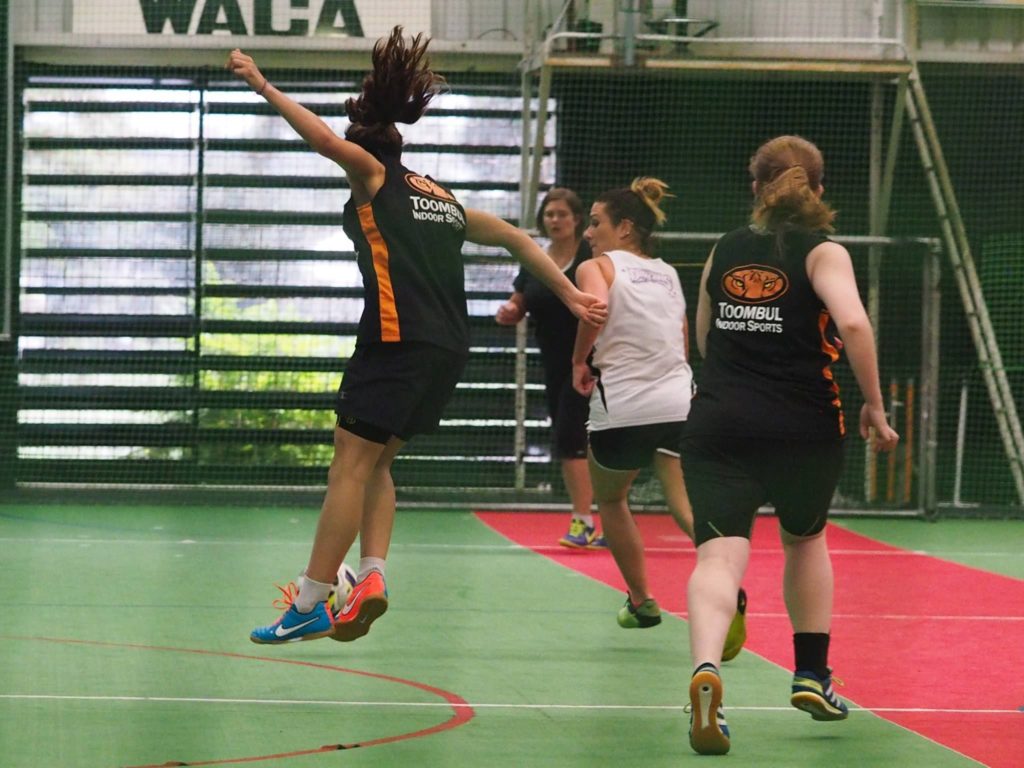We’ve broken down the key elements of the world game, taken indoors for you.
How to Play Indoor Soccer: Here’s How It Works
Indoor soccer is fairly similar to traditional soccer. It uses the same ball, the same principles, and pretty similar techniques.
It sees the playing area reduced in size and so the teams are smaller too — typically a 6-a-side situation. As well as that, it’s played on astro turf and the playing area is surrounded by nets.
So, the rules have been adjusted to accommodate for these slightly different conditions.
There’s no need for boots or tags, no slide tackling is allowed, and rather than awarding a red or yellow card for fouls, you’ll be placed in a timeout box, leaving your team a player short.
You can pick up a pair of indoor soccer-specific shoes if you want, but it’s not essential.
The indoor adaptation sees the 4-4-2 or 4-3-3 formation adapted to a 3-1-1 or a 3-2-1 formation.
Wondering how to play indoor soccer in the technical sense? We got you 👇
How to Play Indoor Soccer: Our top tips for being the GOAT of your indoor soccer team
Perfect your touch
Indoor soccer sees the playing area dramatically reduced, while still using the same ball. It can be super fun to absolutely flog the ball around but taking care and paying attention to your touch can give you one over your competition.
Perfecting your touch will give you amazing control over the ball. There’s two simple ways to gain the control you need.
The first and simplest way is to watch the ball closely and adjust your body to where it’s set to land — then simply popping your foot on top of the ball.
From there you can pull it back or forward to pass on or take a shot.
Then, there’s the ~proper~ way. Again, watch the ball closely and adjust your body accordingly. As the ball approaches, ensure your foot is positioned sideways so the arch-side is where the ball will make contact with.
You can then softly bring your foot back to minimise the impact the ball makes with your shoe — keeping it in your control and your domain, rather than having it snap straight back off your shoe.
In indoor soccer, the ball will travel quicker due to the texture of the ground. It means that using your foot to physically stop the ball will be much simpler in most cases.
Perfect your first touch pass
Your first touch pass or one touch pass is where you pass the ball on the first touch. This is the best technique for attackers when you’re surrounded by defence or for defence when you need to clear the ball quickly.
The key to a first touch pass is to only use the power you need.
The ball already has a bunch of momentum as it’s coming towards you, so you barely need to give it anything.
A push pass is usually going to work better, but toe kicks are great for shots on goal.
It’s all about control and angles though. Practice first touch passes, paying attention to how the spin on the ball affects your pass’ aim.
Push pass to teammates, toe kick to score
Like we said earlier, flogging the ball in indoor soccer is a lot of fun. It’s so rarely necessary though — especially when you’re passing to your teammates.
Always use a push pass (the pass using the side of your foot) to get the ball to nearby teammates, only using the power you need.
Shots on goal are a different story. You need to use a quick snap. This ensures the ball moves quickly enough that the goalkeeper has less time to judge where it’ll land and offers a smaller chance of interception.
Use a toe kick to shoot for the best power and control over the ball.
The surrounding nets are yours to use
While indoor soccer does eliminate the age old “when in doubt, kick it out” technique, it does add a fun element to the game.
With the playing area surrounded by net, you can use the boundaries to evade the other team’s players or snap the ball away, but back to yourself or another teammate to run onto.
Goalies: It’s all in the positioning
Indoor soccer sees the goalkeeper’s job get a heap more interesting. People describe indoor soccer as being like a game of pinball.
It’s not always obvious where the ball is going to land and the time it takes for the ball to travel from one end of the field to the other is insane.
So, goalkeepers need to have quick reflexes and reactions and always be ready.
Like traditional soccer, this means always keeping your eyes on the prize (the ball). But you can position yourself strategically when you’re anticipating a shot on goal too.
You have a shorter cross bar, which means you can stress less about your vertical jump.
By getting yourself into a slight squat position, you can have your body prepared to lunge either way depending on where the ball comes.
—
Interested in playing indoor soccer? You can join one of our leagues to play socially or seriously.
